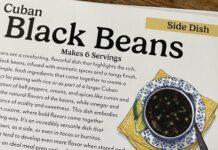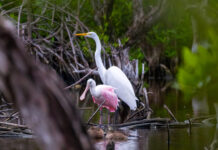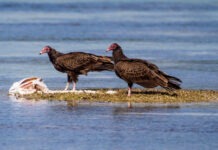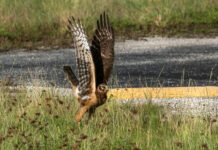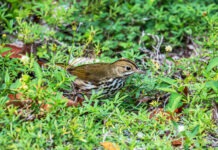In empirical terms, the male northern cardinal is a spectacular bird. Flaming red with a punker’s crest on top of its head, a black mask that suggests a capacity for mischief and a bill that can crack open some pretty tough seeds or, if briefly detained in the loose grip of a human hand, pinch the skin hard enough to leave a mark. (I only had the honor of that happening to me once.)
I think what undermines our sense – or at least my sense – of their spectacularity is the fact that they are everywhere in the U.S., or at least in the eastern two-thirds of the country. Collectively, as a species, they are arguably the most recognizable bird we have in this country. Which might dampen their mystique.
Also, the everydayness of being the logo of not one, but two regional sports franchises might help diminish the wonder.
One of the advantages of living in Key West is that you don’t see cardinals on the island that often. I’m not sure why. The northern cardinal used to be considered a southern species, but with human development and the proliferation of bird feeders, their range now stretches as far north as Maine. And while Key West is pretty urbanized, we somehow don’t see that many cardinals. I’d wonder if Boca Chica or Stock Island might be at the southern extremity of their range – the way squirrels and blue jays disappear from the landscape south of Marathon, but their range stretches well south of us into the Yucatan.
Not seeing cardinals on the regular makes one a little more prone to being taken aback, in the manner fitting of their splendor, when you do see one. (Fun fact: When I just looked up splendor to see if it ended with -er or -or, the example in my MacBook dictionary was “the splendor of the Florida Keys.”)
This taken-abackedness happened to me up on Grassy Key the other day. I was walking down an old road, trying, and failing, to get a better vantage point to see a flamingo, when a male cardinal landed in an angled buttonwood branch a few feet away, most likely checking out what I was up to, mistrustful of me in his territory.
It was late in the day, the sky was that dark pastel blue, and the bird was just this perfect pop of pomp.
Well, look at that, I thought, as if I hadn’t seen a million cardinals in my youth. It’s a good idea to try and appreciate things when the universe gives you a chance to reappraise something.
This sense of revelation-in-the-everyday may have been enhanced by the fact that there seems to have been a dearth of cardinals in the Keys in recent years. My personal theory, formed with anecdotal evidence and hardly any data, is that Hurricane Irma knocked their local population down pretty hard. Before Irma, I remember not being able to drive on Big Torch or Sugarloaf or Big Pine without seeing a cardinal sitting on a utility line every dozen or two telephone poles. Following Irma, that was not the case.
But in the last year or so, I’ve started to see and hear them almost regularly – not back to my sense of their previous numbers, but closer.
Merriam-Webster has an unexpectedly fun and sparky Instagram account. And last week, as if by coincidence, they posted something about the word cardinal, and how it is derived from the Latin word for hinge, as in the things you hang a door on, which evolved into a term for the important elements that make things work, or something that is very important. The Roman Catholic Church then started using it to describe the priests closest in rank to the pope.
Northern cardinals are, of course, not named for their importance, but for the fact that the red of their plumage reminded the early Europeans who came to America of Roman Catholic cardinals, though I read one account that said that their crest was also reminiscent of a cardinal’s mitre.
Besides being good-looking, cardinals are beautiful and persistent singers, and one of their other older common names was the Virginia nightingale, which I’m fond of, largely because it sounds like the name of the tragic heroine in some kind of Southern gothic play.
Female northern cardinals are similar in shape but duller in appearance, more of a ruddy beige with red highlights in the wings, crest and tail. They also sing, though much of their song is sung from the nest, conveying information to their mate as to whether there are predators around and whether it is safe for him and all his flashiness to return.
The intense red in the males comes from their diet. While they have that seed-cracking vise of a bill, they also eat a lot of carotenoid-containing berries and insects that give them their color. In some populations, brighter males have a higher rate of reproductive success. In some populations, they do not.
Male northern cardinals are known for their aggression, especially during breeding season. The punk rock crest has meaning. Reports of their antagonistic relationships with their own images reflected in mirrors or glass are common. Play a tape of their call in their territory, especially of another bird found close to their region, and they will come at you.
The aggression may be linked to the fact that DNA testing shows that between 9% and 35% of northern cardinal chicks come from extra pair copulations.
Besides warding off potential breeding rivals, male northern cardinals also need to guard against predators who want to eat them and their eggs (like raccoons) and nest predators (like cowbirds) who want to lay their eggs in the cardinals’ nests and pawn off raising their chicks.
I’m not sure how long the cardinal on Grassy Key and I regarded each other. A minute, maybe two. Then he dove down and disappeared into the bushes, and I walked back to take some more disappointing pictures of flamingos.

